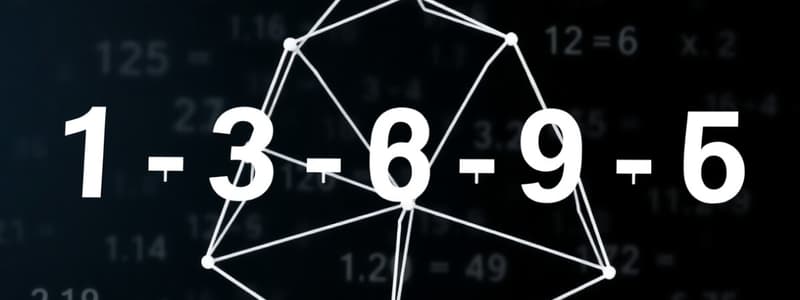Podcast
Questions and Answers
Algebra does not involve variables to represent unknown quantities.
Algebra does not involve variables to represent unknown quantities.
False (B)
Calculus is solely focused on discrete change and does not apply to continuous functions.
Calculus is solely focused on discrete change and does not apply to continuous functions.
False (B)
In statistics, variance is a measure of central tendency.
In statistics, variance is a measure of central tendency.
False (B)
The integral of a function represents the accumulation of a quantity over a period.
The integral of a function represents the accumulation of a quantity over a period.
Factoring an expression simplifies it into a more complex form.
Factoring an expression simplifies it into a more complex form.
Natural numbers include zero.
Natural numbers include zero.
Complex numbers consist of a real part and an imaginary part.
Complex numbers consist of a real part and an imaginary part.
Subtraction can be considered as the inverse operation of division.
Subtraction can be considered as the inverse operation of division.
The number π is classified as a rational number.
The number π is classified as a rational number.
In equations, the expression 2x + 3 = 7 can be solved to find x = 2.
In equations, the expression 2x + 3 = 7 can be solved to find x = 2.
The set operation 'union' combines all distinct elements from two sets.
The set operation 'union' combines all distinct elements from two sets.
Geometry primarily concerns itself with numerical data analysis.
Geometry primarily concerns itself with numerical data analysis.
Irrational numbers can be represented as a fraction of two integers.
Irrational numbers can be represented as a fraction of two integers.
Flashcards
Natural numbers
Natural numbers
Positive whole numbers (1, 2, 3, ...)
Rational numbers
Rational numbers
Numbers that can be written as a fraction (p/q, where p and q are integers, and q is not zero).
Addition
Addition
Combining numbers to find their sum.
Equation
Equation
Signup and view all the flashcards
Subtraction
Subtraction
Signup and view all the flashcards
Algebra
Algebra
Signup and view all the flashcards
Geometry
Geometry
Signup and view all the flashcards
Set
Set
Signup and view all the flashcards
Algebraic Variable
Algebraic Variable
Signup and view all the flashcards
Calculus Derivative
Calculus Derivative
Signup and view all the flashcards
Statistics Mean
Statistics Mean
Signup and view all the flashcards
Algebraic Equations
Algebraic Equations
Signup and view all the flashcards
Calculus Integral
Calculus Integral
Signup and view all the flashcards
Study Notes
Basic Mathematical Concepts
- Mathematics is a fundamental system of logic and reasoning that uses symbolic language to represent and manipulate concepts related to quantity, structure, space, and change.
- Key branches include arithmetic, algebra, geometry, calculus, and statistics.
- Arithmetic deals with basic operations like addition, subtraction, multiplication, and division of numbers.
- Algebra extends arithmetic by using variables to represent unknown quantities and solve equations.
- Geometry focuses on shapes, sizes, and spatial relationships.
- Calculus deals with continuous change, using concepts like derivatives and integrals.
- Statistics involves collecting, organizing, analyzing, interpreting, and presenting data.
Number Systems
- Natural numbers (N): Positive integers (1, 2, 3, ...)
- Whole numbers (W): Natural numbers and zero (0, 1, 2, 3, ...)
- Integers (Z): Whole numbers and their negative counterparts (...-3, -2, -1, 0, 1, 2, 3, ...)
- Rational numbers (Q): Numbers that can be expressed as a fraction p/q, where p and q are integers and q is not zero. Examples include 1/2, 3/4, -2/5.
- Irrational numbers: Numbers that cannot be expressed as a fraction of two integers. Examples include √2, π.
- Real numbers (R): The set of all rational and irrational numbers.
- Complex numbers (C): Numbers that can be expressed in the form a + bi, where a and b are real numbers and i is the imaginary unit (i² = -1).
Operations
- Addition (+) combines two or more numbers to find their sum.
- Subtraction (-) finds the difference between two numbers.
- Multiplication (× or *) combines a number with itself multiple times.
- Division (÷ or /) separates a number into equal parts.
- Exponentiation (^) raises a base number to a power.
- Logarithms (log) find the exponent to which a base must be raised to produce a given number.
Equations and Inequalities
- Equations state that two expressions are equal.
- Inequalities compare two expressions using symbols like < (less than), > (greater than), ≤ (less than or equal to), ≥ (greater than or equal to).
- Solving equations or inequalities involves manipulating the expressions to isolate the variable.
Sets
- A set is a collection of distinct objects.
- Sets can be represented using roster notation (listing elements) or set-builder notation (defining a rule).
- Operations on sets include union, intersection, and complement.
Geometry
- Geometry deals with shapes, sizes, and spatial relationships.
- Basic shapes include points, lines, planes, angles, triangles, quadrilaterals, and circles.
- Formulas exist to calculate areas, volumes, and perimeters of various shapes.
Algebra
- Algebra uses variables to represent unknown quantities.
- Simplifying and solving equations is a core aspect of algebra.
- Factoring an expression breaks it down into simpler expressions that multiply to give the original expression.
- Solving quadratic equations is a common algebraic procedure.
Calculus
- Calculus deals with continuous change.
- Derivatives measure the instantaneous rate of change of a function.
- Integrals determine the accumulation of a quantity over a period.
Statistics
- Statistics involves collecting, organizing, analyzing, interpreting, and presenting data.
- Measures of central tendency include mean, median, and mode.
- Measures of dispersion include variance and standard deviation.
- Probability deals with the likelihood of events occurring.
Studying That Suits You
Use AI to generate personalized quizzes and flashcards to suit your learning preferences.




